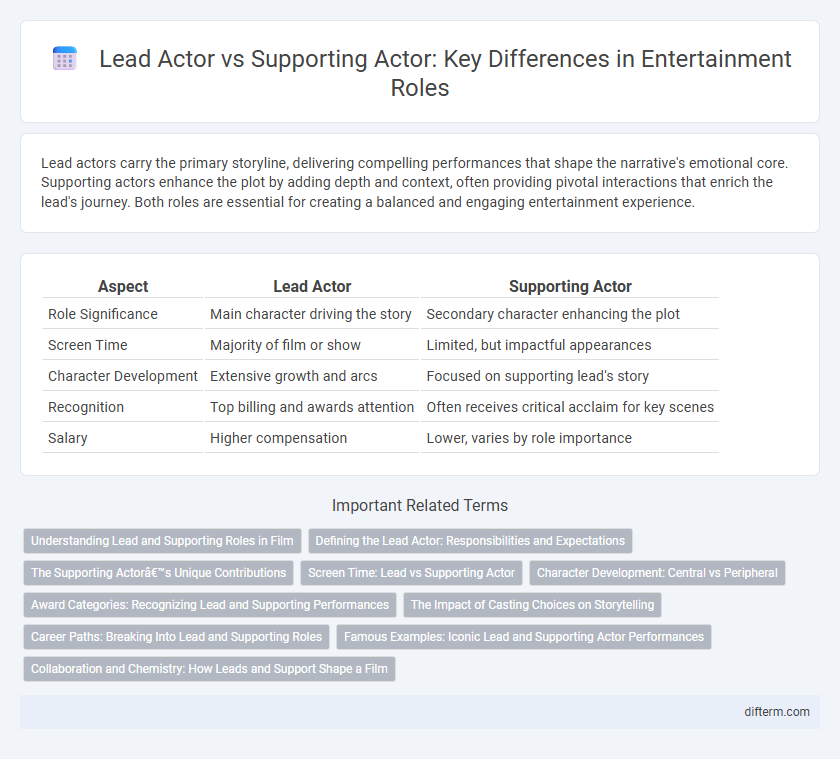Lead actors carry the primary storyline, delivering compelling performances that shape the narrative's emotional core. Supporting actors enhance the plot by adding depth and context, often providing pivotal interactions that enrich the lead's journey. Both roles are essential for creating a balanced and engaging entertainment experience.
Table of Comparison
| Aspect | Lead Actor | Supporting Actor |
|---|---|---|
| Role Significance | Main character driving the story | Secondary character enhancing the plot |
| Screen Time | Majority of film or show | Limited, but impactful appearances |
| Character Development | Extensive growth and arcs | Focused on supporting lead's story |
| Recognition | Top billing and awards attention | Often receives critical acclaim for key scenes |
| Salary | Higher compensation | Lower, varies by role importance |
Understanding Lead and Supporting Roles in Film
Lead actors carry the film's narrative, portraying main characters whose decisions drive the plot and emotional core. Supporting actors enhance the story by providing depth, context, and interaction that highlight the lead's journey and enrich the overall narrative. Recognizing the distinction between lead and supporting roles is crucial for casting, storytelling, and award classifications in the film industry.
Defining the Lead Actor: Responsibilities and Expectations
The lead actor carries the primary narrative weight, embodying the central character around whom the story revolves, requiring a deep emotional range and strong screen presence to engage the audience throughout the film or play. Responsibilities include driving the plot forward, delivering nuanced performances that highlight character development, and often collaborating closely with the director and other key creatives to maintain the story's coherence and impact. Expectations for lead actors emphasize consistency, charisma, and the ability to anchor the ensemble cast, distinguishing them from supporting actors who enhance scenes without bearing the narrative's full burden.
The Supporting Actor’s Unique Contributions
Supporting actors enrich storytelling by adding depth and complexity to the narrative, often portraying memorable characters that enhance the lead actor's performance. Their nuanced interpretations create emotional layers and drive subplots, making the story more engaging and believable. Iconic supporting roles frequently earn critical acclaim and audience admiration, highlighting their essential contributions to the film's overall impact.
Screen Time: Lead vs Supporting Actor
Lead actors typically command the majority of screen time, driving the narrative and emotional core of the film, while supporting actors appear less frequently but provide crucial depth and context to the story. The screen time disparity often influences award categorizations and audience recognition, highlighting the prominence of lead roles in storytelling. Precise quantification varies by script and genre, with leads often appearing in over 60% of scenes compared to supporting actors who may feature in 10-40%.
Character Development: Central vs Peripheral
Lead actors drive the central character development, portraying the protagonist's complex emotions, motivations, and growth that anchor the narrative arc. Supporting actors contribute peripheral character development, enriching the story by adding depth and context through secondary roles that highlight or contrast the lead's journey. This dynamic enhances storytelling by balancing the protagonist's transformation with meaningful interactions and subplots.
Award Categories: Recognizing Lead and Supporting Performances
Award categories distinctly recognize lead actors and supporting actors to highlight their unique contributions to storytelling. Lead actor awards honor performers who carry the primary role and narrative focus, while supporting actor awards acknowledge those who enhance the story through secondary but crucial roles. These distinctions ensure a balanced appreciation of diverse acting talents within the entertainment industry.
The Impact of Casting Choices on Storytelling
Lead actors drive the narrative by embodying central characters whose journeys shape the plot's progression and emotional depth. Supporting actors enhance storytelling by adding layers of context, enriching the lead's performance, and providing critical interactions that deepen audience engagement. Strategic casting choices for both roles influence the film's tone, believability, and overall impact on viewers, ultimately shaping the story's resonance and success.
Career Paths: Breaking Into Lead and Supporting Roles
Lead actors often establish their careers by securing breakthrough roles that showcase their range and charisma, positioning themselves as central figures in major productions. Supporting actors typically build their portfolios through diverse character roles that demonstrate versatility and reliability, gradually gaining recognition and industry trust. Transitioning from supporting to lead roles requires strategic role selection, networking, and consistently delivering compelling performances that capture audience and producer attention.
Famous Examples: Iconic Lead and Supporting Actor Performances
Iconic lead performances like Marlon Brando in *The Godfather* showcase commanding screen presence and character depth, defining the film's narrative. In contrast, standout supporting roles such as Heath Ledger's Joker in *The Dark Knight* deliver unforgettable complexity and elevate the primary storyline. These performances highlight the unique contributions of lead and supporting actors in shaping cinematic history.
Collaboration and Chemistry: How Leads and Support Shape a Film
Lead actors drive the narrative's emotional core, while supporting actors enrich the story's depth and authenticity, creating a dynamic interplay essential for compelling cinema. Their collaboration fosters on-screen chemistry that enhances character development and audience engagement. Effective synergy between leads and supporting roles elevates the film's overall impact, balancing star power with nuanced performances.
lead actor vs supporting actor Infographic

 difterm.com
difterm.com